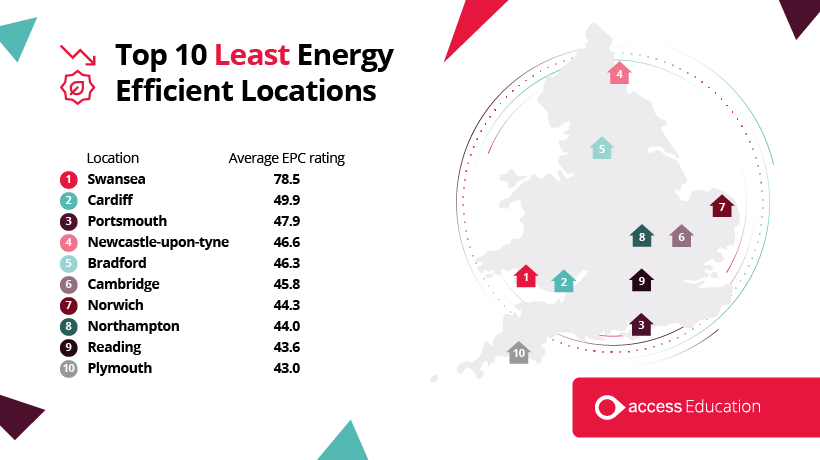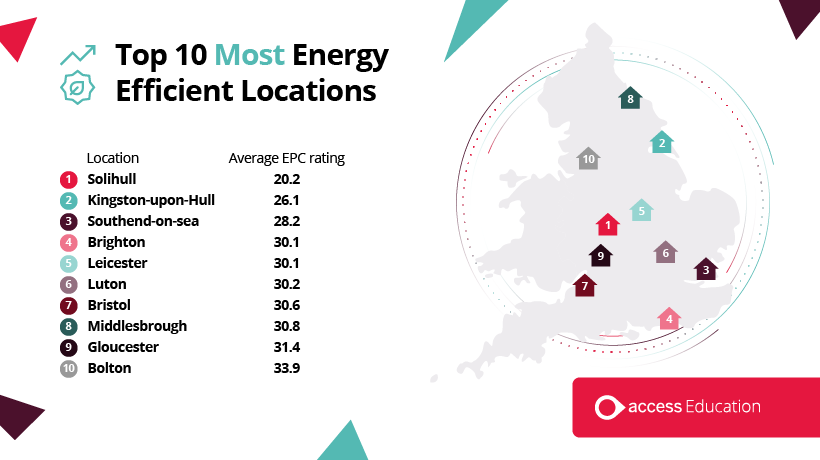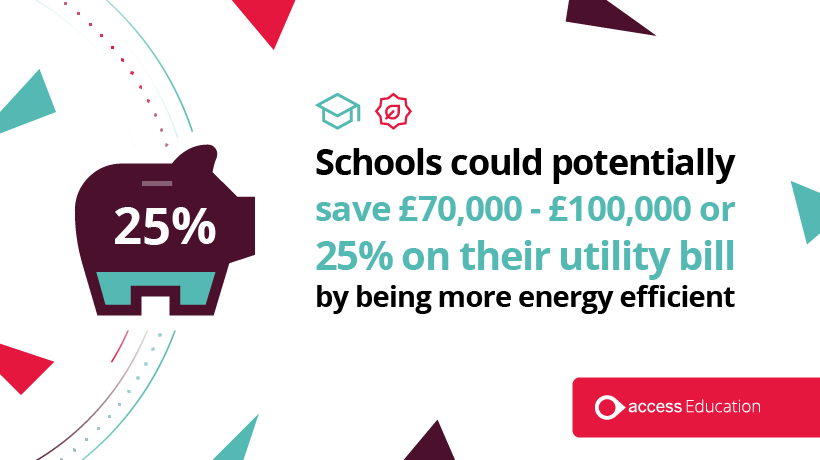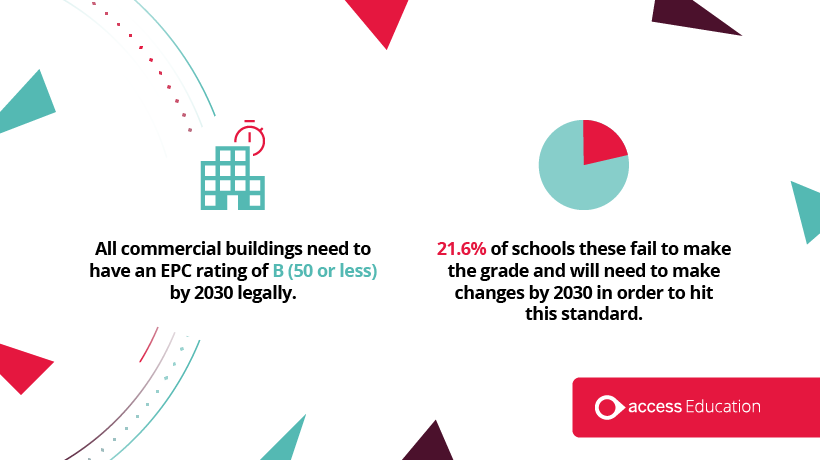 Access Education Budgets
Access Education Budgets
Where are the most energy efficient schools in England and Wales?
The Energy Relief Scheme could save schools up to 61% on their bills – but only if their infrastructure is as efficient as possible. We reveal new data that shows how each region is performing, with advice on how to manage energy usage and costs.

For many years to come, 2022 will be defined as the start of the most turbulent economic era since the 2008 financial crisis.
According to the Office for National Statistics (ONS), the Consumer Prices Index, which includes owner occupiers’ housing costs (CPIH), grew by almost 10% in the months to October 2022 – with many of these costs attributed to services such as gas, electricity and other fuels.
The effect this is having on the general public is well documented. People across the UK are left scrutinising their spending to keep their families warm this winter and in schools, the same is true. Following the teacher salary rise in September, school funding was already spread incredibly thin. Yet headteachers and school business managers are left readjusting budgets once more to cope with bills that are much higher than they could have forecasted last year.
In September, the Government announced its Energy Relief Scheme for non-domestic customers, including schools, which some research says could save the education sector up to 61% on its bills. The Autumn statement also announced an additional £2.3 billion funding for schools – but without exact details on how this will be distributed many experts speculate its effectiveness, with some suggesting that any help for energy bills could end after March next year.
Even with financial aid, it’s important for school infrastructure to be up to date and efficient in order to rely on less energy and in turn, waste less cash.
This is particularly challenging for schools, which often rely on industrial heating oil (IHO) units for a large proportion of their energy. The price of oil is not currently protected under the energy price cap, though its use is covered under the Energy Prices Bill.
We wanted to learn more about the current landscape, and conducted research into different regions to find out which area has the most and least energy efficient schools across England and Wales.
The need for energy efficiency in schools
Energy efficiency has long been a priority for schools, but the conversations around it are constantly changing. The record-breaking heatwave of summer 2022, which forced many schools to shut, brought climate change to the forefront of people’s minds – in the week that followed, the number of people who selected ‘climate change’ as the most important issue facing the country rose from 23% to 33%.
Now, as the temperatures have dropped, inflation reached record levels and gas prices soared. One survey even showed that a majority of respondents would support temporarily increasing the amount of energy the UK generates from high carbon sources in order to prevent blackouts and reduce energy bills. Having an energy efficient home, office or school is now imperative for financial stability, as well as mitigating the impact of the climate emergency.
Robert Gould is partner at property consultancy, Barker Associates, and is a specialist in the education sector. He agrees that the issue facing schools is twofold, stating that:
“Heating school buildings and providing hot water is both costly and carbon intensive. In the current context of stretched budgets and the climate emergency there is an imperative to reduce costs and cut carbon emissions.
“The cheapest energy is the energy you don’t use. The biggest impact schools can have on their energy consumption in the short term is to optimise heating controls and programmers and review temperature settings. For more complex systems this may require specialist engineering advice.”
Which region’s schools in England and Wales are the least energy efficient?
To conduct our research, we calculated the average Energy Performance Certificate (EPC) rating for secondary schools in 50 locations across England and Wales, using an online tool from the government.
An EPC rating is given to a property after being assessed by specialists, grading it from A (most efficient) to G (least efficient), as well as a numerical score. For residential properties, a score of 92 or more will give it a grade A. However in commercial properties, including schools, a lower number is needed with 0-25 typically leading to a grade A score.
Overall, schools in Swansea were revealed as having the lowest EPC ratings with an average of 78.5, or a grade D, which makes it the least energy efficient area across England and Wales. Elsewhere in Swansea, however, residents are benefitting from one of Europe’s largest green retrofit projects which powers homes from batteries charged by solar panels.
Another Welsh city, Cardiff, was the second poorest performing area with a 49.9 score, which is a grade B – but almost in the grade C bracket.
When only looking at schools in England, Portsmouth is the least energy efficient area, and the third least energy efficient overall, with an average rating of 47.9, grade B.
Top 10 least energy efficient locations for schools

It’s good news for schools in Solihull, which is the most energy efficient area in the study. Schools in the West Midlands town have the highest average rating of 20.2, and is the only area featured in the research with a grade A score.
The average rating for all schools measured in the sample of most and least energy efficiency areas is 38.2, and a grade B.
Top 10 most energy efficient locations for schools

Additional energy reporting for schools
EPCs are the most familiar tool for monitoring a building’s energy performance, however there are other ways that schools can measure their carbon and energy usage. In 2020, the Education & Skills Funding Agency (ESFA) issued new guidance on Streamlined Energy and Carbon Reporting (SECR) for finance teams within Multi Academy Trusts (MATs).
Local Authority maintained schools will also have a Display Energy Certificate (DEC) to showcase a building’s energy use and carbon emissions.
Simple ways to make energy savings in schools
Robert Gould explained some simple ways that schools can reduce their energy use:
“Based on a recent survey, our team discovered that around 60% of the energy consumed at a typical school is when there are no students in the building, so switching off appliances and devices when not in use can have a large effect when done across an organisation.
“Another analysis of 350 of the largest trusts in the UK representing 5200 schools, found that eliminating Halving the non-open element (30%) of electricity consumption would save £96 million – of course, these figures just show the potential for savings, and should always be done by making incremental changes through timers and temperature settings.
“For a typical secondary school with a utility bill between £300,000 - £400,000, a saving of £70,000 - £100,000 should be achievable.
“In the longer term, Solar Photovoltaic (PV) Panels, LED lighting and building fabric insulation will have the biggest impact on energy efficiency.”
"It’s just an indicator of the size of the opportunity. You wouldn’t ever completely turn off heating systems which would typically have frost protection etc in place and be set up to turn on to reach operating temp at agreed operating hours."

The importance of budget planning for schools
Although the average EPC score for most schools measured was grade B, the true figure can vary dramatically from building to building. One individual score in Swansea reached as low as 324, which is grade G, while another school in Solihull, which is the most energy-efficient region on average, scored 88, grade D.
In 2019, the government revealed new plans for commercial buildings to reach EPC rating B, or 49 or less, by 2030. Although this doesn’t apply to schools specifically, 21.6% of the schools in this sample are grade C or lower and would have improvements to make to reach the new targets should they come into force.

Specialist solutions such as budget planning software for schools can help leaders to recalculate budgets to ensure essential costs are met, but it’s no wonder many are left making difficult decisions on how they can provide children with an education, without running out of money this winter.
Many schools have already considered reducing their opening days or even teaching staff to cope with the rising costs. Independent schools may need to raise fees or reduce scholarships, and will be relying on effective parent communication and feedback during this changeable time.
State schools, which are responsible for paying their own energy bills, will be particularly affected, with one headteacher saying: “I had budgeted for a £50,000 surplus in the current year, but with energy costs at least doubling and staff costs going up – and teachers deserve a pay rise – we are now heading for a £30,000 deficit.”
Navigating the storm
Of course, education isn’t the only sector that will struggle with its finances during the cost of living crisis – Multi Academy schools and trusts are not for profit organisations, and could learn from how charities kept their operations running despite falling donations and funding during the peak of the Covid-19 pandemic.
Digital transformation was a key factor. Not only for boosting levels of fundraising, but to streamline back-end operations such as financial reporting. One charity, which manages more than 65 shops, saved around £50,000 a year on efficiencies by switching to a system that integrated with its HR, payroll and donor management tools.
Even as resources are stretched, using specialist budget planning software for schools could help headteachers and school business managers to keep track of costs. It’s possible to forecast scenarios up to five years in advance based on predicted peaks and troughs, such as payments from the Energy Relief Scheme and calculate budgets on real-life circumstances rather than on vague estimations. Similarly, accounting software for schools keeps essential bookkeeping efficient as well as DfE and ESFA compliant, so school leaders can focus their time on adding value elsewhere, while the system offers financial peace of mind.
The Priestley Academy Trust in West Yorkshire uses technology to monitor expenditure over the course of a year, and to, “keep a close eye on concerning trends, before they cause problems.”
Prior to using budget planning software for schools, the Learning Partners Academy Trust would often find itself with surplus funds at the end of each financial year, which could have been spent on educational provision.
With a robust reporting process it now ensures schools are aware of every resource available to them – this level of transparency will prove crucial for schools this winter and beyond.
Methodology for data collection
- We took the top 50 locations in England and Wales based on population size using this list from The Geographist: https://www.thegeographist.com/uk-cities-population-1000/
- For schools that had multiple EPC certificates, we used the figure for the main building or main block where possible.
- For schools with expired EPC certificates (likely due to delays caused by the pandemic), we have taken the certificate with the most recent expiry date.
- Only locations with more than five schools with certificates were featured in the final results - Sale was therefore excluded from the final sample.

 AU & NZ
AU & NZ
 SG
SG
 MY
MY
 US
US
 IE
IE